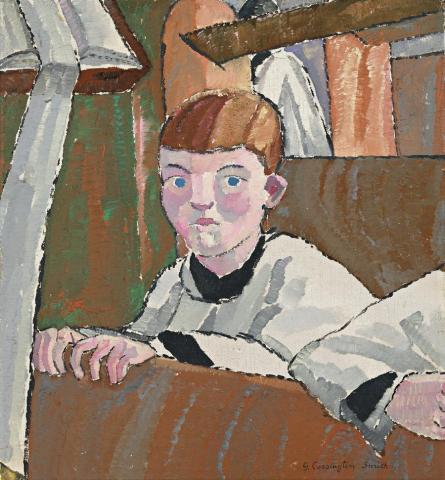CHOIR BOY, 1927
GRACE COSSINGTON SMITH
oil on canvas on board
34.0 x 31.0 cm
signed lower right: G Cossington Smith
Macquarie Galleries, Sydney (label attached verso)
Private collection, Sydney
Deutscher Fine Art, Melbourne
Private collection, Melbourne
Grace Cossington Smith, Grosvenor Galleries, Sydney 4 July 1928, cat. 8
Grace Cossington Smith, Macquarie Galleries, Sydney, 3–15 March 1976, cat. 5
Australian and Australia-Related Fine Art: 1830s–1970s, Deutscher Fine Art, Melbourne, 25 November – 11 December 1987, cat. 108 (illus. in exhibition catalogue)
Grace Cossington Smith is best known for her light-filled still life paintings, landscapes, and home interiors, celebrating the wondrous beauty of creation. In summarising her approach, she said, 'All form - landscape, interiors, still life, flowers, animals, people - has an articulate grace and beauty, painting to me is expressing this form in colour, colour vibrant with life - but containing this other, silent quality which is unconscious, and belongs to all things created.'1 As a devout Anglican, whose art is filled with such devotional joy, it is surprising that paintings based directly on religious subjects are so rare. True, she painted two interiors in the forties. Church Interior c1941-42, with its surpliced choir, is in the Queensland Art Gallery, and Thanksgiving Service 1945 is in the Fred and Elinor Wrobel collection, John Passmore Museum of Art, Sydney. Painted within the context of the Second World War, they are of more biographical interest. Both show the Church of St James at Turramurra, Cossington Smith's place of regular worship. It was newly rebuilt in 1941, about the time of the first painting. The second commemorates the War's end, one of a number of paintings revealing her involvement and concern. In the early fifties, in response to the establishment of the Blake Prize for religious art, she completed two Biblical paintings. Then One of Them, Which Was a Lawyer, Asked Him a Question 1952 (illustrating an episode in the life of Christ), is in the collection of the National Gallery of Australia, Canberra, and I Looked, and Behold, A Door was Opened in Heaven 1953 is held privately. Both show the influence of the Italian early Renaissance masters Masaccio and, her favourite, Fra Angelico on her work.
During the latter part of the 1920s Cossington Smith was a part-time art teacher at the progressive Turramurra College, the inspiration for the painting Boys Drawing 1926-27 (National Gallery of Victoria, Melbourne). It reveals her ready ease with children in an approach that is direct and touched with humour. Choir Boy 1927, painted close in time, is strikingly similar in its light heartedness and affectionate approach, especially the disarmingly direct, quizzical stare. Compositionally, it has the informality of a snapshot. There is a look of seemingly angelic innocence that is often associated with young boy sopranos and recollection of the miraculous beauty of their voices. While the black cassocked and white surpliced choir is a feature of Anglican worship, the prominence of the open Bible on the lectern points to its importance and centrality in worship. Like all her art, Choir Boy is not a specifically religious painting. There was no need of such, for she found the spiritual in the everyday, its radiance expressed through her use of light and colour.
1. The artist, quoted in Horton, M., Present Day Art in Australia, Ure Smith, Sydney, 1996, p. 203
DAVID THOMAS
